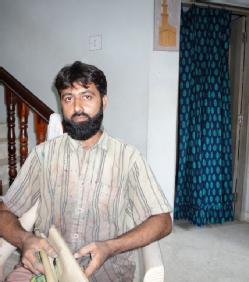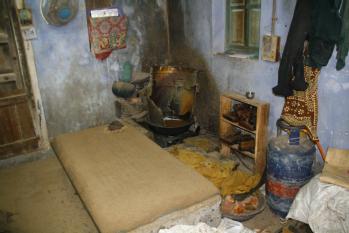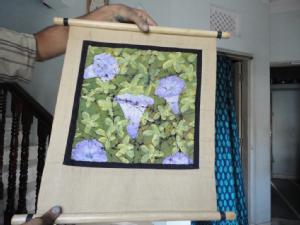Shakeel Ahmed Khatri
(Qasim Haji's son)
|
Age: 30 Occupation: batik printer Education: Class 10 Residence: Mundra Date of interview: 28/5/2012
|
|
 |
Interview Summary
Mundra-based Shakeel Ahmed learnt batik printing from his father and his maternal and paternal uncles. Historically, Mundra, Anjar, Valsad, and Bhuj were the main production centres of this craft. Talking of his family history, Shakeel told us that once the family household consisted of sixty-six members, all of whom were engaged in batik printing. Now, things have changed and the family is more dispersed. The members of the family involved in batik are the fifth generation to do so, but the methods used have changed little over the years. The women in the family tie bandhaniand also manage the household, and therefore have little time to be involved in any of the stage of batik printing process.
 In the first stage of the batik process, white cloth is taken and de-starched by soaking overnight in a soda water, and is subsequently washed. For printing, the white cloth is coated with wax and dyed. The exact process of both wax coating and dyeing depends upon the colours to be used; the number of colours equates to the number of times the printing and dyeing process is carried out. Paraffin wax is used, and is kept in a vessel above a burner or stove, ensuring the wax stays fluid. As the hot wax is sprinkled on the cloth, the sand pads below cool the wax to prevent smudging. This laborious and tedious work necessitates a great degree of care and focus. The wax covers the design, which then resists the dye. Wax is also used as a resist on those parts of the fabric which will be dyed a shade different from the base colour. The natural hairline cracks in the wax coating give the characteristic effect of batik. Shakeel identifies that as the ‘character of batik’. The look is spontaneous, dappled and unique, giving the fabric a remarkable look. Shakeel adds that thinner fabric is more effective for creating a sharp design.
In the first stage of the batik process, white cloth is taken and de-starched by soaking overnight in a soda water, and is subsequently washed. For printing, the white cloth is coated with wax and dyed. The exact process of both wax coating and dyeing depends upon the colours to be used; the number of colours equates to the number of times the printing and dyeing process is carried out. Paraffin wax is used, and is kept in a vessel above a burner or stove, ensuring the wax stays fluid. As the hot wax is sprinkled on the cloth, the sand pads below cool the wax to prevent smudging. This laborious and tedious work necessitates a great degree of care and focus. The wax covers the design, which then resists the dye. Wax is also used as a resist on those parts of the fabric which will be dyed a shade different from the base colour. The natural hairline cracks in the wax coating give the characteristic effect of batik. Shakeel identifies that as the ‘character of batik’. The look is spontaneous, dappled and unique, giving the fabric a remarkable look. Shakeel adds that thinner fabric is more effective for creating a sharp design.
Another unique feature of batik followed by Shakeel’s family which distinguishes the art from other types of batik is uses of blocks for applying the wax and designs. In this process a carved wooden block is immersed in melted paraffin wax and printed on white cloth. Elsewhere, a brush is used for applying the wax. Shakeel explains that for different types of motifs the printing technique also varies. For instance, for the gadhdesign, negative is printed and positive is not printed; the part of the design not incorporated in the motif is waxed, rather than the other way around. The design range includes floral and geometric shapes. Shakeel himself has developed an acute sense of design after a course at Kalaraksha. Shakeel was made more aware of the importance of his craft due to his training at Kalaraksha too, which stressed the significance of retaining the traditions and originality of the art form. Having realised the value of block printing he then persuaded his family members to preserve many of the old blocks.
Shakeel told us that previously, only sadlasfor the Patels were made. Another popular garment was Kotadia which was printed in a red and black design for the Khatri weddings known as Ijaz (parallel worn below the gown). Kotia has been in vogue for many years for both the Hindu and Muslim Khatris. The other traditional motifs are kachbo, kanski, and jalebi. The start range of their batik fabric is 70 to 80 rupees per meter, and it reaches up to 500 rupees per meter if on silk.
 Shakeel’s family have a workshop of about twenty five year old and including Shakeel, four family members looks after the work of making, marketing and supervising workers. There are four workers engaged in printing, and five others for painting, washing and waxing. Shakeel is aware of the Indonesian and Malaysian batik art. Their technique is different as their key instrument is a chilam (smoke holder) for creating the designs. Today, Shakeels markets are mostly local – Ahmedabad is particularly important – and he has so far not launched his products at the international level.
Shakeel’s family have a workshop of about twenty five year old and including Shakeel, four family members looks after the work of making, marketing and supervising workers. There are four workers engaged in printing, and five others for painting, washing and waxing. Shakeel is aware of the Indonesian and Malaysian batik art. Their technique is different as their key instrument is a chilam (smoke holder) for creating the designs. Today, Shakeels markets are mostly local – Ahmedabad is particularly important – and he has so far not launched his products at the international level.
Shaqeel’s brother is not involved in the family business and instead has developed a career in IT. The whole business is looked after by his father, two uncles and himself. His uncle’s son has a separate business. Though the whole family is struggling hard to revive and retain their century-old business, they are not happy with the response they receive for their dying art. Shakeel and his aunt Khalida Ayub (age 35) together expressed their disappointment with the fact that batik seems not to be as valued as the other crafts of India. They feel that their craft is ignored and often is not mentioned in lists of traditional art forms both in Kachchh and at a national level. Shakeel in a disheartened tone told us that in the award list they appear nowhere. He also added that when tourists visit Kachchh they are primarily interested in the four more ‘popular’ arts, namely ajrakh, bandhani, weaving and embroidery. None of the new designers or researchers think of batik either. Another thing that bothers them is the geographic location of Mundra which is situated in the south west of Kachchh. Its location has an impact in terms of the number of tourists who come to visit them. Shakeel explained that Bhuj, Bhujodi and Ajrakhpur are in close proximity to each other and can be visited together; visiting Mundra requires a separate travel itinerary.
Shakeel also described how, several years ago, many of the batik workers indiscriminately plunged into making the loongi(lower garment for the male) and to compete with each other they substantially reduced the rates of their product. In the long-run, not only were quality and design compromised but batik itself became associated with loongi. This was brought home to Shakeel at an exhibition when a lady was drawn to buy a batik-printed sari but was discouraged by her husband who dismissed it as loongi.
To break into foreign markets, the major hurdle these batik craftsmen face is regarding the usage of chemical dye. Eco-friendly vegetable dyes are valued abroad. But this is challenging for Shakeel as paraffin wax, an essential component of the batik process, reacts badly to acetic natural dyes such as hardeand alum. They are trying to find a viable solution to this problem. Through Kalaraksha, Shakeel has approached Jaggana Rajappa, a batik artist of vast experience who maintains over 600 workshops, to ask about alternatives.
Yet, things are not all that gloomy for the family. The Ahmedabad-based Gamthi outlet purchases eighty per cent of their production and they are content with that. The workers are paid in two ways. The printer is paid per meter and others are paid per day. It purely depends upon the worker how many meters he can complete in a day and therefore how much he can earn. Generally, per day a printer can print 130 to 140 meters at the rate two Rupees per meter. This work must all be of a specified quality however. The printers come at seven in the morning and work still seven in the evening with an hour lunch break. The dying work starts little later, from around nine o’clock.
Shakeel is aware of the history of his port town that was once a prosperous mercantile centre. Its shipping businesses flourished and there were regular contacts with Muscat. He was also aware of Ibji Shivji, a business person and brother of Jairam Shivji, a famous tycoon of Zanzibar.
Khalida, Shakeel’s aunt and at whose house the interview took place, was warm in welcoming us and also shared her experience of her craft. She has two daughters Zakiya and Jaima. Zakia is seventeen years old and is keen to join the design institute at Jaipur. It is very rare that the children belonging to artisan families take an ardent interest in advanced studies. It is even more unusual for Khatri females, most of whom tie bandhaniand teach their daughters to do the same. Khalida says that if they do not tie they feel empty; without an hour or two of their day set aside to tie they feel that it has gone to waste.
Looking at the hard work that has gone in their wide range of beautiful saris, dresses, stoles and scarves it seems that Shakeel and Khalida are right when they complain that their craft is sorely neglected.
*Kindly refer to the summary of Qasim Haji for some more information on Batik printing process
